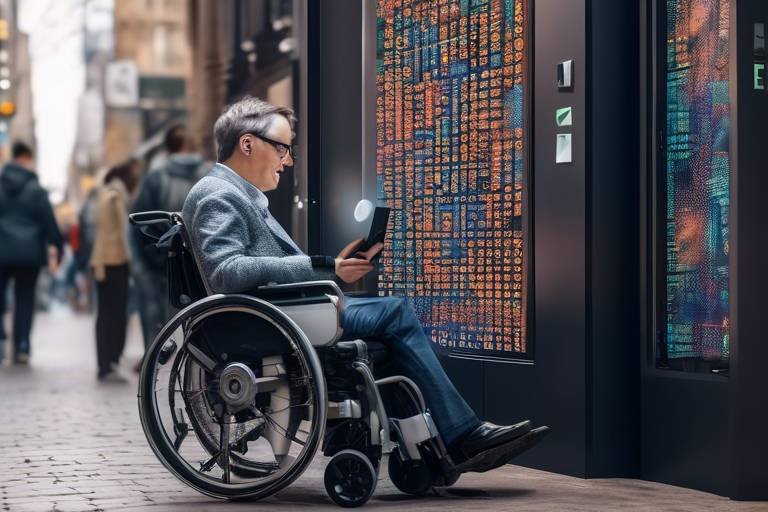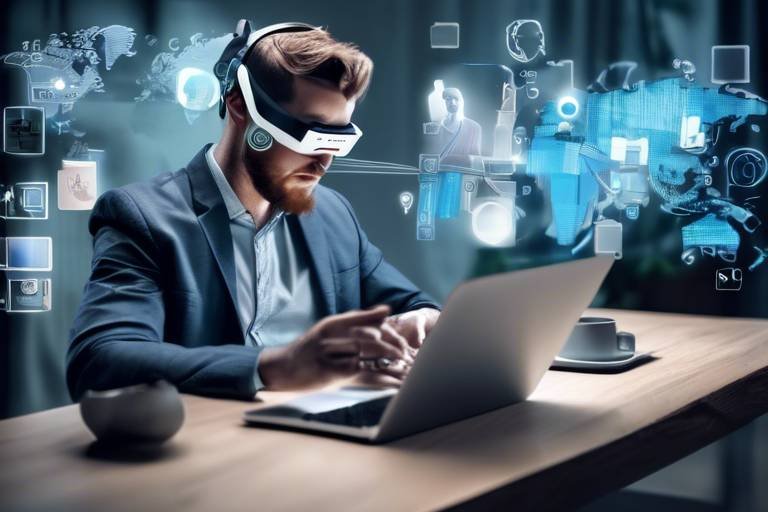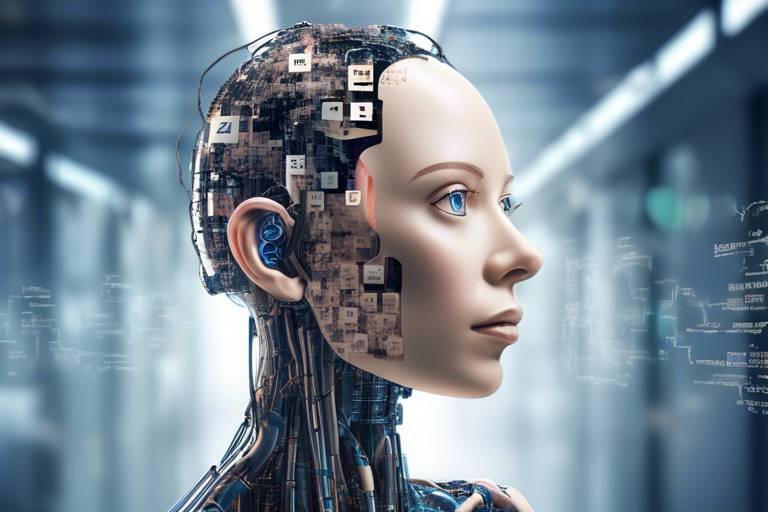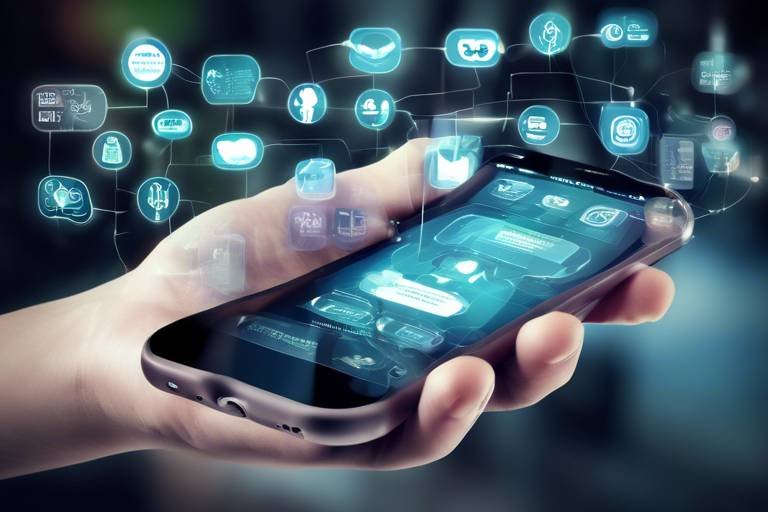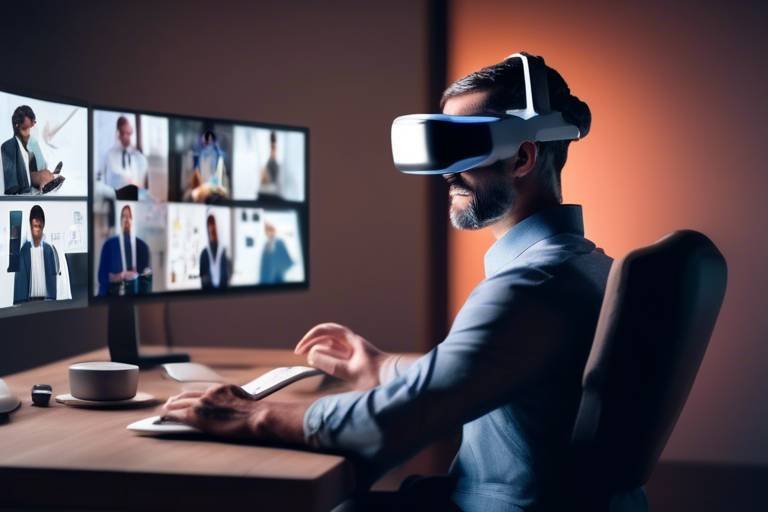The Role of AI in Enhancing Accessibility for All
In today's fast-paced world, technology plays a pivotal role in shaping our daily lives. However, for many individuals with disabilities, accessing this technology can feel like navigating a maze with no exit. Fortunately, artificial intelligence (AI) is stepping in to transform this landscape, making technology more inclusive and accessible for everyone. Imagine a world where a simple voice command can open doors, where real-time translations bridge communication gaps, and where personalized learning tools adapt to individual needs. This is not just a dream; it's the reality that AI is creating as it enhances accessibility for all.
As we delve into the impact of AI on accessibility, it's essential to recognize the challenges that individuals with disabilities face. These challenges are not just physical barriers; they encompass a range of issues including cognitive, sensory, and mobility impairments. For example, consider the frustration of someone who is deaf trying to navigate a website without captions or a visually impaired person struggling to identify objects in their environment. These scenarios highlight the urgent need for innovative solutions that can break down these barriers.
AI is revolutionizing the way we approach these challenges. By leveraging advanced technologies, we can create tools and applications that not only assist individuals with disabilities but also empower them. Whether it's through speech recognition systems that allow users to control devices hands-free or natural language processing that enables more intuitive interactions, the innovations are both exciting and impactful. Moreover, AI-driven technologies are not just limited to personal use; they extend into public spaces, education, and workplaces, fostering an environment where everyone can thrive.
In the following sections, we will explore specific AI innovations that are enhancing accessibility. From speech recognition to visual navigation, we'll uncover how these technologies are reshaping the lives of individuals with disabilities. Additionally, we will discuss the profound impact of AI on education, creating tailored learning experiences that promote inclusivity. As we look to the future, the possibilities are endless, and the journey towards a more accessible world is just beginning.
- What is AI's role in accessibility? AI helps to create technologies that make it easier for individuals with disabilities to interact with devices and access information.
- How does speech recognition technology assist individuals with disabilities? It allows users with mobility impairments to control devices using voice commands, enhancing their independence.
- What are some examples of AI innovations in education? Personalized learning tools and virtual classrooms are key examples that adapt to the needs of students with disabilities.
- What future trends can we expect in AI accessibility? Advancements in AI could lead to even more inclusive technologies, improving accessibility in various aspects of life.

Understanding Accessibility Challenges
When we talk about accessibility, it’s essential to recognize that the challenges faced by individuals with disabilities are as diverse as the people themselves. Imagine trying to navigate a world designed without consideration for your specific needs—frustrating, right? From visual impairments to mobility issues, each challenge requires unique solutions. The barriers can often feel insurmountable, but understanding them is the first step toward creating a more inclusive environment.
For many individuals, daily interactions with technology can be a daunting task. Consider someone with a hearing impairment trying to engage in a video call without captions. Or think about a person with a visual impairment attempting to read a website that isn’t optimized for screen readers. These scenarios highlight the pressing need for innovative solutions that can bridge the gap and provide equal access to technology.
Some common barriers include:
- Physical Barriers: These include inaccessible websites, poorly designed software, or hardware that doesn't accommodate various disabilities.
- Communication Barriers: For individuals with hearing or speech impairments, traditional communication methods can be limiting, isolating them from social interactions.
- Information Barriers: Many online resources are not designed with accessibility in mind, making it difficult for individuals with disabilities to find and understand information.
Each of these barriers can severely impact a person's ability to interact with technology effectively. It’s like trying to solve a puzzle where some pieces are missing; without the right tools and support, the picture remains incomplete. The need for innovative solutions is not just a matter of convenience; it’s about ensuring that everyone has the opportunity to participate fully in society.
In essence, addressing accessibility challenges is about more than just compliance with regulations; it’s about fostering an environment where everyone can thrive. As we delve deeper into the role of AI in enhancing accessibility, we’ll explore how these technologies are breaking down barriers and creating a more inclusive world for all.

AI Innovations in Assistive Technology
Artificial intelligence is not just a buzzword; it's a powerful tool that's reshaping the landscape of assistive technology. Imagine a world where individuals with disabilities can navigate their daily lives with the same ease as anyone else. That’s the promise of AI innovations in assistive technology. These advancements are not only enhancing independence but are also significantly improving the quality of life for many. From smart home devices to advanced communication tools, AI is making technology more inclusive than ever before.
One of the standout innovations in this realm is the development of smart speech recognition systems. These systems allow individuals with mobility impairments to control their devices using voice commands. Think about how liberating it must feel for someone who has difficulty using their hands to simply speak to their devices and have them respond. This technology has evolved dramatically, with AI algorithms now capable of understanding various accents and dialects, making them more user-friendly and accessible. The accuracy of these systems has improved to the point where they can recognize commands even in noisy environments, which is a game-changer for many users.
Another exciting area is Natural Language Processing (NLP). This technology enables devices to understand and respond to human language in a more natural way. For instance, users can engage in conversations with their devices, asking questions or giving commands in a more intuitive manner. Imagine a visually impaired person asking their smart assistant to read out the labels of items in their pantry. Thanks to NLP, these interactions are becoming smoother and more effective, bridging the gap between technology and human needs.
Moreover, AI-powered real-time translation services are breaking down language barriers, particularly for individuals with hearing impairments. These services can transcribe spoken language into text almost instantaneously, allowing for seamless communication in diverse settings. Picture a deaf person participating in a meeting where everyone else is speaking. With real-time translation, they can read the conversation as it unfolds, ensuring they are included in the dialogue. This technology not only fosters communication but also enhances social inclusion.
Visual recognition technologies are another remarkable advancement in assistive tech. For those with visual impairments, AI can assist in navigation and object recognition. Imagine a visually impaired person walking down the street and having their smartphone alert them to obstacles or guide them to their destination using audio cues. This kind of technology is not just about convenience; it's about empowering individuals to explore their environments safely and confidently.
In conclusion, the innovations in AI-driven assistive technology are paving the way for a more inclusive world. As these technologies continue to evolve, they promise to dismantle barriers and create opportunities for individuals with disabilities to thrive. The potential is limitless, and the impact on society is profound.

Speech Recognition Systems
Imagine a world where your voice commands can open doors, send messages, and control your environment. are making this a reality, particularly for individuals with mobility impairments. These systems allow users to interact with technology using their voice, transforming the way they engage with devices. The integration of artificial intelligence has significantly enhanced the accuracy and usability of these systems, making them more accessible than ever before.
At the core of speech recognition technology is the ability to convert spoken words into text. This technology relies on complex algorithms and machine learning models to understand various accents, dialects, and speech patterns. For many, this means the difference between being able to use a smartphone or computer independently or relying on someone else for assistance. With AI, these systems are continuously learning and improving, adapting to the unique speech characteristics of each user.
One of the most exciting advancements in speech recognition is the incorporation of contextual understanding. AI-driven systems can interpret not just the words being said but also the context in which they are spoken. This allows for more natural interactions. For instance, if a user says, "Turn on the lights," the system understands that the command refers to the home lighting system rather than a different device. This contextual awareness is a game-changer, making technology feel more intuitive and user-friendly.
Furthermore, the integration of speech recognition systems into everyday devices has been revolutionary. From smart home assistants to mobile applications, these technologies are everywhere. For example, many people now use voice-activated assistants like Amazon's Alexa or Google Assistant to control their home environments. This has opened up a world of possibilities for individuals with disabilities, allowing them to manage their homes and lives more independently.
However, challenges remain. While AI has made significant strides in speech recognition, issues like background noise and varying speech clarity can still hinder performance. Developers are actively working on solutions to improve the robustness of these systems. Noise-cancellation technology and advanced signal processing techniques are being researched to enhance the clarity of voice commands, ensuring that users can communicate effectively, regardless of their environment.
In summary, speech recognition systems powered by AI are not just technological novelties; they are essential tools that enhance the independence and quality of life for individuals with disabilities. As these systems continue to evolve, we can expect even greater improvements in their accuracy and usability, paving the way for a more inclusive digital world.

Natural Language Processing
Natural Language Processing, or NLP, is like the magic wand of the tech world, especially when it comes to making our interactions with devices feel more human. Imagine talking to your smartphone or computer as if you were chatting with a friend—this is what NLP aims to achieve! By allowing devices to understand and interpret human language, NLP is revolutionizing accessibility for individuals with disabilities. It transforms how users engage with technology, making it more intuitive and user-friendly.
For individuals with various disabilities, traditional methods of input can be challenging. This is where NLP steps in, bridging the gap between human communication and machine understanding. Whether it's converting spoken words into text or interpreting commands given in natural speech, NLP enhances the interaction experience significantly. It opens up a world of possibilities for those who may struggle with conventional input methods, such as typing or using a mouse.
One of the most exciting aspects of NLP is its ability to learn and adapt. As users interact with systems powered by NLP, these systems become smarter over time. They can recognize patterns in speech, understand context, and even pick up on emotional cues. This adaptability is crucial for creating a more personalized experience, ensuring that technology meets the unique needs of each user.
Consider this: when you speak to a voice assistant, it doesn't just hear your words; it processes them, understands your intent, and provides a relevant response. This level of interaction is particularly beneficial for individuals with cognitive impairments, as it reduces the cognitive load required to interact with technology. By simplifying communication, NLP empowers users to navigate the digital landscape with greater confidence and ease.
Moreover, NLP can enhance accessibility features in various applications, from text-to-speech software to automated customer service chatbots. Here are a few key ways NLP is making a difference:
- Voice-Activated Assistants: These tools allow users to control devices hands-free, making daily tasks easier and more accessible.
- Smart Text Prediction: By anticipating what users want to type, NLP reduces the effort needed for those with motor impairments.
- Contextual Understanding: NLP systems can grasp the context of conversations, allowing for more meaningful interactions.
As we move forward, the integration of NLP into various technologies promises to create even more inclusive environments. Imagine a world where everyone, regardless of their abilities, can seamlessly communicate with technology. With ongoing advancements and a focus on accessibility, NLP is paving the way for a future where technology is truly for everyone.
Q: What is Natural Language Processing (NLP)?
A: NLP is a technology that enables machines to understand, interpret, and respond to human language in a way that is both meaningful and useful.
Q: How does NLP improve accessibility for individuals with disabilities?
A: NLP enhances accessibility by allowing users to interact with technology using natural language, making it easier for those with physical or cognitive impairments to communicate and control devices.
Q: Can NLP systems learn from user interactions?
A: Yes, NLP systems can learn and adapt based on user interactions, improving their accuracy and personalization over time.
Q: What are some applications of NLP in assistive technology?
A: NLP is used in voice-activated assistants, text-to-speech software, and smart text prediction tools, among others, to enhance user experience and accessibility.

Real-Time Translation Services
In our increasingly globalized world, communication is key, yet it can often be a significant barrier for individuals with hearing impairments. powered by artificial intelligence are breaking down these barriers, enabling smoother interactions and fostering social inclusion. Imagine being in a crowded café, where conversations buzz around you, and suddenly, you can understand every word being said, regardless of the language. This is the magic of AI-driven translation technology.
These services utilize advanced algorithms to convert spoken language into text instantly, offering a lifeline to those who may struggle to follow verbal discussions. By employing machine learning and natural language processing (NLP), these systems can not only translate but also contextualize conversations, making them more relevant and understandable. For example, when someone speaks a phrase laden with cultural references, the AI can interpret it in a way that resonates with the user’s knowledge and experience.
Furthermore, the integration of real-time translation services into various platforms—such as video conferencing tools and mobile applications—has revolutionized communication. Now, individuals with hearing impairments can participate in meetings, lectures, and social gatherings without feeling left out. This technology is not just a luxury; it is a necessity for creating inclusive environments where everyone can engage fully.
To illustrate the impact of these services, consider the following table that outlines some of the key features and benefits of real-time translation technologies:
| Feature | Benefit |
|---|---|
| Instant Text Display | Allows users to read spoken language in real-time, facilitating immediate understanding. |
| Multi-language Support | Enables communication across different languages, promoting inclusivity in diverse settings. |
| Contextual Understanding | Enhances the relevance of translations, making conversations more engaging and meaningful. |
| Integration with Communication Tools | Seamlessly fits into existing platforms, ensuring accessibility in various environments. |
As we look to the future, the potential for real-time translation services to evolve is immense. With continuous advancements in AI, we can expect even greater accuracy, more languages supported, and features that enhance user experience. The goal is clear: to create a world where communication is as effortless as breathing, ensuring that everyone, regardless of their abilities, can connect and share ideas freely.
By embracing these technologies, we are not just improving accessibility; we are paving the way for a more inclusive society where every voice matters. So, the next time you engage in a conversation, remember that technology is working behind the scenes to ensure that no one is left out of the dialogue.

Visual Recognition and Navigation
For individuals with visual impairments, the world can often feel like a maze, filled with obstacles that are invisible to the eye. However, thanks to advancements in artificial intelligence, navigating through life is becoming increasingly easier and more intuitive. Visual recognition technologies are at the forefront of this revolution, enabling users to interact with their environment in ways that were once thought impossible. Imagine walking down a busy street and having your smartphone announce the names of shops and street signs in real-time. This is not just a dream—it's a reality for many people today.
At the core of these innovations are sophisticated algorithms that can analyze images and recognize objects, people, and even facial expressions. These systems utilize deep learning techniques to improve their accuracy over time, making them more reliable for everyday use. For instance, an AI-powered navigation app can provide verbal directions while identifying nearby landmarks, ensuring that users can safely reach their destinations without relying solely on sight. This technology not only enhances independence but also empowers users to engage more fully with their surroundings.
In addition to navigation, visual recognition technologies can assist with daily tasks. Here are some examples of how these tools are making a difference:
- Object Recognition: AI can identify household items, helping users locate their belongings quickly.
- Facial Recognition: This feature allows individuals to recognize friends and family members, fostering social connections.
- Scene Description: AI can describe the environment, providing context and enhancing spatial awareness.
Moreover, the integration of these technologies into wearable devices, like smart glasses, is paving the way for a more immersive experience. These devices can provide real-time feedback, allowing users to navigate complex environments with ease. Just think about the possibilities—going to a new city and having a personal assistant that not only guides you but also helps you discover local attractions, all while ensuring your safety. It’s like having a trusty sidekick who never leaves your side!
As we look to the future, the potential for AI in visual recognition and navigation is boundless. With ongoing research and development, we can anticipate even smarter systems that will continue to break down barriers for those with visual impairments. The goal is not just to enhance mobility but to create a more inclusive world where everyone, regardless of their abilities, can thrive. The journey has just begun, and the destination is a society that embraces diversity through technology.
- What is visual recognition technology?
Visual recognition technology uses AI to identify and interpret images, helping users understand their surroundings better. - How does AI improve navigation for visually impaired individuals?
AI enhances navigation by providing real-time audio feedback about the environment, such as street names and nearby objects. - Are there any wearable devices that utilize visual recognition?
Yes, smart glasses and other wearable devices are being developed that incorporate visual recognition to assist users in daily tasks. - What are the future trends in visual recognition technology?
The future may see advancements in accuracy, integration with other smart devices, and even more personalized user experiences.

The Impact of AI on Education
Artificial Intelligence (AI) is not just a buzzword; it’s a game-changer, especially in the realm of education. Imagine a classroom where every student, regardless of their abilities, can learn in a way that suits them best. Sounds like a dream, right? Well, thanks to AI, this dream is becoming a reality. AI is reshaping educational accessibility by providing tailored learning experiences that cater to the unique needs of students with disabilities. It’s like having a personal tutor that understands your learning style, pace, and preferences.
One of the most significant advantages of AI in education is its ability to create personalized learning tools. These tools are designed to adapt to the individual needs of each student. For instance, a student with dyslexia might benefit from software that reads text aloud while highlighting words, making it easier to follow along. On the other hand, a student with hearing impairments could use AI-driven captioning tools that transcribe spoken words in real-time. The beauty of AI lies in its flexibility; it can be tailored to meet diverse learning needs, ensuring that no one gets left behind.
Moreover, the rise of virtual classrooms has transformed the landscape of education. Remote learning has become more prevalent, and AI plays a crucial role in making this transition smoother for students with disabilities. With AI-enhanced platforms, students can engage in interactive lessons from the comfort of their homes. These platforms often include features like speech recognition, which allows students to participate in discussions through voice commands, and AI-driven analytics that help educators track progress and adjust teaching methods accordingly.
As we dive deeper into the impact of AI on education, it’s essential to recognize the challenges it aims to overcome. Traditional educational systems often struggle to accommodate diverse learning needs, leading to feelings of isolation among students with disabilities. AI is addressing these challenges head-on by promoting inclusivity. For example, AI can analyze a student's performance data and suggest personalized resources that cater to their specific learning gaps. This proactive approach not only enhances understanding but also builds confidence among students.
To give you a clearer picture, let’s consider a few examples of how AI is being utilized in educational settings:
| AI Tool | Functionality | Benefit |
|---|---|---|
| Speech Recognition Software | Transcribes spoken words into text | Helps students with hearing impairments engage in lessons |
| Personalized Learning Platforms | Adapts content based on learning pace | Ensures students learn at their own speed |
| AI-Powered Tutoring Systems | Provides real-time feedback and support | Enhances comprehension and retention of information |
In conclusion, the impact of AI on education is profound and far-reaching. It not only enhances accessibility but also fosters a more inclusive environment where every student can thrive. As we move forward, it’s exciting to think about the endless possibilities AI holds for reshaping education. By continuing to innovate and integrate AI into educational practices, we can ensure that all students, regardless of their abilities, have the opportunity to succeed.
- How does AI improve accessibility in education? AI enhances accessibility by providing personalized learning experiences and tools that cater to the unique needs of students with disabilities.
- What are some examples of AI tools used in education? Examples include speech recognition software, personalized learning platforms, and AI-powered tutoring systems.
- Can AI help students with learning disabilities? Yes, AI can provide tailored resources and support, helping students with learning disabilities to engage more effectively in their education.

Personalized Learning Tools
In today's fast-paced world, the traditional one-size-fits-all approach to education simply doesn't cut it anymore, especially for students with disabilities. Enter , powered by artificial intelligence (AI), which are revolutionizing the educational landscape. These tools are designed to adapt to the unique needs and learning styles of each student, ensuring that everyone has the opportunity to thrive academically.
Imagine walking into a classroom where every student is engaged, not just because of the subject matter, but because the content is tailored specifically for them. AI-driven personalized learning tools make this a reality by using data analysis and algorithms to assess a student's strengths, weaknesses, and preferences. This allows educators to create customized learning experiences that enhance comprehension and retention.
For instance, consider a student with dyslexia. Traditional reading materials may pose significant challenges, but AI can help by providing text-to-speech functionalities or adjusting the text format to be more readable. These adjustments can make a world of difference, enabling students to access the same information as their peers without feeling overwhelmed. Additionally, personalized learning tools can track progress over time, giving educators valuable insights into what strategies are working and where adjustments need to be made.
Moreover, these tools are not just limited to reading and writing. They encompass a wide range of subjects and skills, including mathematics, science, and even social skills. For example, AI can create interactive simulations for science experiments, allowing students to learn through hands-on experiences that are tailored to their individual learning pace. This approach not only boosts engagement but also fosters a deeper understanding of complex concepts.
Furthermore, personalized learning tools often incorporate gamification elements, turning learning into an exciting adventure. When students can earn rewards or progress through levels, they are more likely to stay motivated and engaged. This is particularly beneficial for students who may struggle with traditional learning methods. By making education fun and interactive, AI helps to break down barriers and create a more inclusive environment.
In summary, personalized learning tools powered by AI are transforming the educational experience for students with disabilities. They offer tailored support, foster engagement, and promote independence. As technology continues to advance, we can only imagine the incredible possibilities that lie ahead in creating truly inclusive educational environments.
- What are personalized learning tools?
Personalized learning tools are educational technologies that adapt to the individual needs and learning styles of students, particularly those with disabilities, to enhance their learning experience. - How does AI improve personalized learning?
AI improves personalized learning by analyzing student data to create customized learning paths, offering tailored resources, and tracking progress to ensure effective learning outcomes. - Can personalized learning tools be used in all subjects?
Yes, personalized learning tools can be applied across various subjects, including reading, writing, mathematics, and science, making education more accessible and engaging for all students. - Are personalized learning tools effective for all students?
While these tools are particularly beneficial for students with disabilities, they can also enhance the learning experience for all students by accommodating different learning styles and paces.

Virtual Classrooms and Remote Learning
The advent of virtual classrooms has been nothing short of revolutionary, especially for students with disabilities. Imagine a world where every student, regardless of their physical limitations, can access high-quality education from the comfort of their home. This transformation is made possible through the integration of artificial intelligence in remote learning environments. AI technologies are not just enhancing the learning experience; they are breaking down traditional barriers that have long hindered educational accessibility.
One of the most significant advantages of virtual classrooms is the flexibility they offer. Students can learn at their own pace, which is crucial for those with learning disabilities or other challenges. For instance, AI-driven platforms can analyze a student's performance and customize the curriculum accordingly. This means that if a student struggles with a particular concept, the system can offer additional resources, exercises, or even alternative explanations until the student feels comfortable. The result? A more personalized learning journey that caters to individual needs.
Moreover, virtual classrooms equipped with AI can provide real-time feedback, which is essential for maintaining engagement. Imagine a scenario where a student can ask questions and receive instant answers, facilitating a dynamic learning environment. This not only helps in clarifying doubts but also encourages students to participate actively, fostering a sense of community and collaboration. The use of video conferencing tools and interactive platforms allows students to connect with peers and instructors, creating a supportive network that is vital for social inclusion.
However, the benefits of virtual classrooms extend beyond just personalized learning. AI technologies can also assist in creating accessible content. For example, text-to-speech and speech-to-text applications ensure that students with visual or hearing impairments can engage with the material effectively. Additionally, features such as closed captioning and sign language interpretation can be integrated seamlessly into virtual lessons, making them more inclusive. These tools not only improve comprehension but also empower students to participate in discussions and express their thoughts without feeling marginalized.
To illustrate the impact of AI in virtual classrooms, consider the following table that outlines key features and their benefits:
| Feature | Benefit |
|---|---|
| Real-Time Feedback | Enhances engagement and allows for immediate clarification of concepts. |
| Personalized Learning Paths | Caters to individual learning speeds and styles, fostering better understanding. |
| Accessible Content | Ensures all students can engage with materials through various formats. |
| Collaborative Tools | Encourages interaction and community building among students. |
As we look to the future, the potential for AI in remote learning is boundless. With continuous advancements in technology, we can expect even more innovative solutions that will further enhance accessibility for all students. The goal is clear: to create an educational landscape where every individual, regardless of their abilities, has the opportunity to thrive.
- How does AI improve accessibility in virtual classrooms?
AI personalizes learning experiences, provides instant feedback, and creates accessible content, ensuring all students can participate fully. - What are the benefits of remote learning for students with disabilities?
Remote learning offers flexibility, personalized pacing, and access to assistive technologies that traditional classrooms may lack. - Will AI replace teachers in virtual classrooms?
No, AI is designed to assist teachers by providing tools that enhance the learning experience, not to replace the human element of education.

Future Trends in AI Accessibility
As we look ahead, the landscape of AI accessibility is poised for remarkable transformations that promise to make technology even more inclusive for individuals with disabilities. With rapid advancements in artificial intelligence, we can expect a future where accessibility is not just an afterthought but a fundamental component of technological development. Imagine a world where every person, regardless of their physical or cognitive abilities, can seamlessly interact with technology. This vision is becoming increasingly attainable as AI continues to evolve.
One of the most exciting trends is the integration of machine learning algorithms that adapt to individual user needs. These algorithms can analyze user behavior and preferences, allowing devices to personalize experiences in real-time. For instance, consider a visually impaired user navigating a smart home. Future AI systems could learn their specific routes, preferences for lighting, and even voice commands, creating a customized environment that responds intuitively to their needs.
Moreover, advancements in augmented reality (AR) and virtual reality (VR) are set to revolutionize accessibility. Imagine using AR glasses that provide real-time information about surroundings, helping those with visual impairments to navigate spaces more effectively. Or consider VR environments that simulate real-world scenarios for individuals with autism, helping them practice social interactions in a safe and controlled setting. These technologies not only enhance accessibility but also empower individuals to engage with their environments in new and meaningful ways.
Another trend is the development of collaborative AI systems that work alongside human caregivers and educators. These systems can provide real-time feedback and support, enhancing communication and understanding. For instance, in an educational setting, AI could assist teachers in identifying students' unique learning challenges, offering tailored resources that cater to diverse learning styles. This collaborative approach ensures that no one is left behind, fostering an environment where everyone can thrive.
Furthermore, the push for greater data privacy and security is essential as we advance into a future dominated by AI. With the increasing reliance on AI for accessibility, it is crucial to ensure that user data is protected and used ethically. Future innovations will likely include enhanced encryption methods and user-controlled data sharing options, allowing individuals to manage their information while still benefiting from AI technologies.
As we embrace these trends, it's important to consider the broader implications of AI accessibility. The goal is not just to create tools but to foster an inclusive society where everyone has equal access to opportunities. This means involving individuals with disabilities in the development process, ensuring their voices are heard, and their needs are prioritized.
In conclusion, the future of AI accessibility is bright, filled with potential innovations that can drastically improve the lives of individuals with disabilities. By embracing these advancements, we can create a world where technology is not just accessible but also empowering, allowing everyone to participate fully in society.
- What is AI accessibility?
AI accessibility refers to the use of artificial intelligence technologies to enhance the usability of devices and applications for individuals with disabilities, ensuring that everyone can access and benefit from technological advancements. - How can AI improve communication for individuals with hearing impairments?
AI can provide real-time translation services and enhanced speech recognition, allowing individuals with hearing impairments to communicate more effectively. - What role does machine learning play in accessibility?
Machine learning algorithms can analyze user behaviors and preferences, enabling personalized experiences and adaptive technologies that cater to individual needs. - Are there any ethical concerns regarding AI accessibility?
Yes, data privacy and security are significant concerns. It's essential to ensure that user data is protected and used ethically while developing AI technologies.
Frequently Asked Questions
- What is the role of AI in enhancing accessibility?
AI plays a crucial role in making technology more inclusive for individuals with disabilities. By providing innovative solutions, AI helps break down barriers, allowing everyone to access and interact with technology more effectively.
- What are some common accessibility challenges faced by individuals with disabilities?
Individuals with disabilities often face various challenges, such as difficulty in using standard devices, limited access to information, and barriers in communication. These challenges can hinder their ability to fully participate in society, highlighting the need for advanced, AI-driven solutions.
- How does speech recognition technology improve accessibility?
Speech recognition technology allows individuals with mobility impairments to control devices using their voice. AI enhances these systems by increasing accuracy and usability, enabling users to perform tasks hands-free, which significantly improves their independence.
- What is Natural Language Processing (NLP) and how does it aid accessibility?
NLP enables more intuitive interactions between users and devices by allowing technology to understand and process human language. This capability improves accessibility features in various applications, making it easier for individuals with disabilities to communicate and navigate technology.
- How do AI-powered real-time translation services help individuals with hearing impairments?
AI-driven real-time translation services facilitate communication for individuals with hearing impairments by converting spoken language into text or sign language instantly. This technology fosters social inclusion and enhances the ability to participate in conversations and activities.
- What advancements have been made in visual recognition technologies for accessibility?
Visual recognition technologies assist those with visual impairments by enhancing navigation and object recognition. AI algorithms can identify and describe surroundings, helping users to move confidently and independently in their environments.
- How is AI reshaping educational accessibility?
AI is transforming educational accessibility by providing personalized learning experiences tailored to the needs of students with disabilities. These tools enhance engagement and comprehension, ensuring all students have equal opportunities to succeed in their educational journeys.
- What are personalized learning tools and how do they benefit students with disabilities?
Personalized learning tools powered by AI adapt to individual learning styles and needs, allowing students with disabilities to engage more effectively with educational content. This customization helps improve understanding and retention of information.
- How has remote learning impacted accessibility for students with disabilities?
The rise of virtual classrooms has made education more accessible for students with disabilities. AI facilitates remote learning by providing adaptive tools and resources, ensuring that all students can participate and thrive in an online learning environment.
- What future trends can we expect in AI accessibility?
As technology continues to evolve, we can anticipate even more innovative solutions aimed at enhancing accessibility through AI. Future trends may include more sophisticated assistive technologies, improved user interfaces, and expanded applications in various sectors to ensure inclusivity for all individuals.

